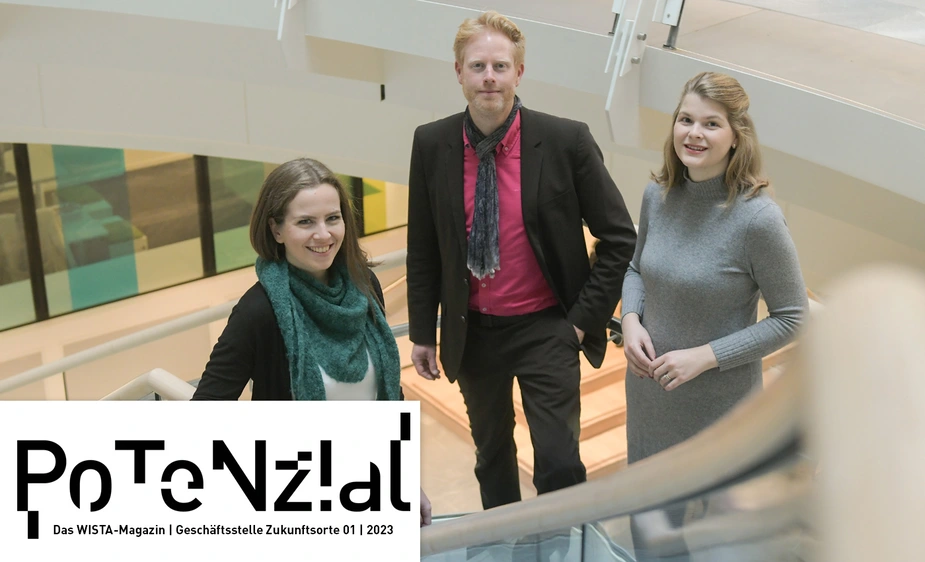An eye on the future
The Zukunftsorte Business Office aims to network Berlin's research and development locations more closely and create free space for innovation
“The best way to predict the future is to create it.” Alan Kay is credited as the inventor of the term “personal computer” and was one of the computer scientists who always kept in mind the practical use that their research findings might have in the future. He is widely credited for this witticism. Berlin, too, plans on creating its own future. To this end, it now has set up eleven sites generating future innovation, so-called Zukunftsorte, which are turning research findings into new products, applications, and technologies. The Zukunftsorte Business Office connects all these places. It facilitates networking among its members on the inside, promotes their interests to the outside, develops brands, and acts as a point of contact and a communicator on regional, national, and international markets.
Berlin was once an industrial city. It became famous as “Elektropolis” across the globe in the 19th and 20th centuries. This was thanks to “electric” global players like Siemens or AEG, short for Allgemeine Elektrizitäts-Gesellschaft, who were drivers of technological progress and electrification. “After the World War, the Cold War, German division, and Berlin’s insular position, there wasn’t much left in the late 1980s,” says Steffen Terberl, head of the Zukunftsorte Business Office. He adds: “Except for science and research, which was still there.” Around the two, technology parks were designed, universities integrated, infrastructure modernised, and entire districts built. Today, these places are to help Berlin reindustrialise and to significantly contribute to creating the future of the city.
Berlin’s Zukunftsorte include Adlershof Technology Park in the southeast, the EUREF Campus and Campus Charlottenburg, and Urban Tech Republic in the northwest. They are to act as a beacon for the entire city. The Senate of Berlin concluded, however, that Berlin’s research and development locations must cooperate even more closely with each other. In pure officialese, it decided to write the creation of “intra-regional regional management” into its coalition agreement.
Terberl and his business office colleagues, Noémi Dombi and Katia Ernst, stick to what is already the yardstick for every individual Zukunftsort: “Define, profile, network, market. We must make visible what happens in these places.” It includes treatment for atrial fibrillation, seat belts for joints, and counting sensors for optimising public transportation in buses and trains. Before anything else, Terberl wants to make Berliners aware of what is being produced in Berlin’s Zukunftsorte. “Creating awareness on one’s doorstep,” is what he calls this. Moving around the city today, you will see posters advertising the Zukunftsorte everywhere. How can we rid the world of plastic waste? Preserve biodiversity? Or defeat diseases like cancer? “We run campaigns that package complex issues in simple messages,” says Terberl. They did so by highlighting how science and research are working together for a better future on 146 so-called City Light pillars and 237 so-called Public Video Stations. “We want to create a dialogue based on issues,” says Steffen Terberl, determinedly. For him, it’s about communicating science, forming initiatives, and hosting events, including a recent Climate Day. “Of course, not all the places are homogeneous but there is significant overlap.”
Despite different profiles, they must tackle similar challenges – their range includes regulation and heritage conservation, knowledge, and technology transfer, as well as the issue of attracting the best talent. “We need an exchange of experiences, to bring the right people in a room together, and attract the media’s attention,” explains Terberl, who is a geographer by trade. The Zukunftsorte boast pioneers from science, industry, and technology. “We as a society can no longer afford to constantly struggle with these challenges. I would like to see more pragmatism, speed, and greater openness, for example, when it comes to sustainable construction and exploiting patents, or working to attract the brightest minds to Berlin from other countries. Innovation needs freedom,” Terberl argues.
He has been working on the interface of research and industry for a long time, most recently as head of Profund Innovation, a Free University of Berlin agency that supports students, researchers, and alumni in starting new companies. He has been heading the Zukunftsorte Business Office since April 2022. “A lot is happening,” he says, “a creative and innovative ecosystem is being created. To be involved in this is really intriguing.”
Rico Bigelmann for POTENZIAL
